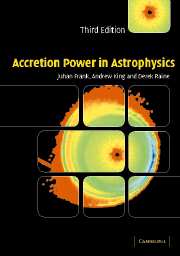Book contents
- Frontmatter
- Contents
- Preface to the first edition
- Preface to the second edition
- Preface to the third edition
- 1 ACCRETION AS A SOURCE OF ENERGY
- 2 GAS DYNAMICS
- 3 PLASMA CONCEPTS
- 4 ACCRETION IN BINARY SYSTEMS
- 5 ACCRETION DISCS
- 6 ACCRETION ON TO A COMPACT OBJECT
- 7 ACTIVE GALACTIC NUCLEI
- 8 ACCRETION DISCS IN ACTIVE GALACTIC NUCLEI
- 9 ACCRETION POWER IN ACTIVE GALACTIC NUCLEI
- 10 THICK DISCS
- 11 ACCRETION FLOWS
- Appendix: Radiation processes
- Problems
- Bibliography
- Index
4 - ACCRETION IN BINARY SYSTEMS
Published online by Cambridge University Press: 05 June 2012
- Frontmatter
- Contents
- Preface to the first edition
- Preface to the second edition
- Preface to the third edition
- 1 ACCRETION AS A SOURCE OF ENERGY
- 2 GAS DYNAMICS
- 3 PLASMA CONCEPTS
- 4 ACCRETION IN BINARY SYSTEMS
- 5 ACCRETION DISCS
- 6 ACCRETION ON TO A COMPACT OBJECT
- 7 ACTIVE GALACTIC NUCLEI
- 8 ACCRETION DISCS IN ACTIVE GALACTIC NUCLEI
- 9 ACCRETION POWER IN ACTIVE GALACTIC NUCLEI
- 10 THICK DISCS
- 11 ACCRETION FLOWS
- Appendix: Radiation processes
- Problems
- Bibliography
- Index
Summary
Introduction
The importance of accretion as a power source was first widely recognized in the study of binary systems, especially X-ray binaries. This is still the area where the greatest progress in the understanding of accretion has been made. The reason for this is simply that, by their very nature, binaries reveal more about themselves, notably their masses and dimensions, than do other astronomical objects. This is particularly true in the case of eclipsing binaries, where we get direct information about spatial relations within the source. The importance of accretion is further manifested by the realization that probably a majority of all stars are members of binary systems which, at some stage of their evolution, undergo mass transfer.
The detailed study of interacting binary systems has revealed the importance of angular momentum in accretion. In many cases, the transferred material cannot land on the accreting star until it has rid itself of most of its angular momentum. This leads to the formation of accretion discs, which turn out to be efficient machines for extracting gravitational potential energy and converting it into radiation. This property has made accretion discs attractive candidates for the role of the central engine in quasars and active galactic nuclei; the question of whether or not this assignment is correct will be a theme of later chapters. In the context of binaries, however, their existence and importance is well attested through observation; we shall discuss the evidence for this in Chapter 5.
- Type
- Chapter
- Information
- Accretion Power in Astrophysics , pp. 48 - 79Publisher: Cambridge University PressPrint publication year: 2002



